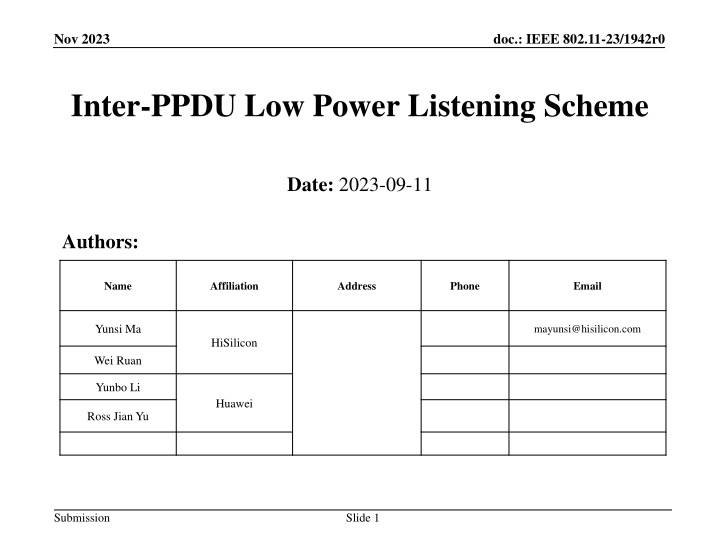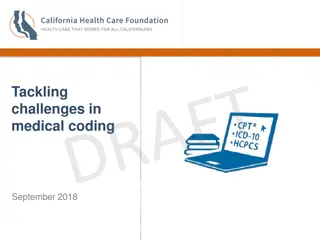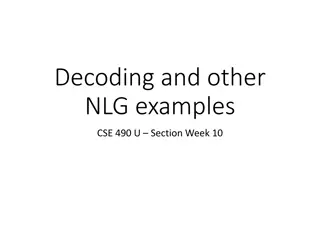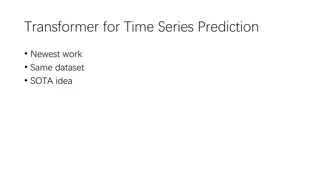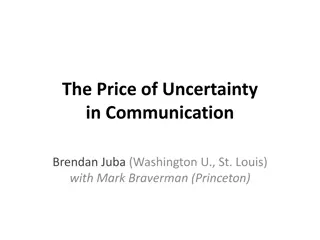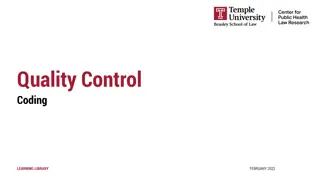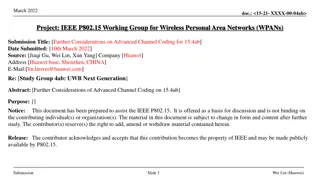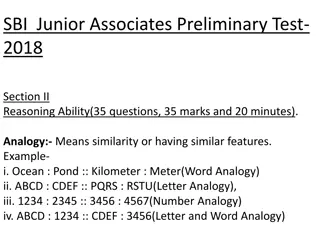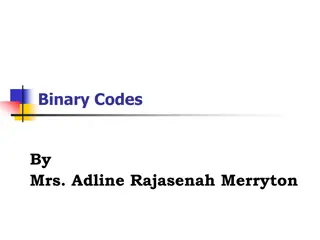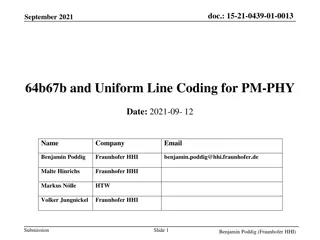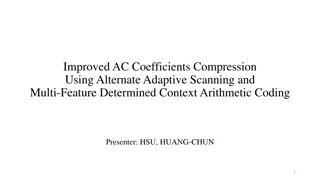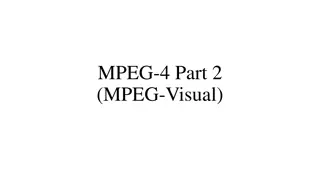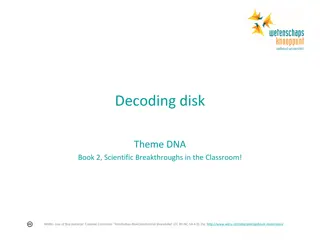Types of Coding-Decoding Techniques
various types of coding-decoding techniques such as letter coding, coding by analogy, coding in fictitious language, coding by substitution, coding by shifting words, coding based on conditions, and mathematical operation-based coding. Challenge yourself with practice questions to improve your skills.
Download Presentation

Please find below an Image/Link to download the presentation.
The content on the website is provided AS IS for your information and personal use only. It may not be sold, licensed, or shared on other websites without obtaining consent from the author.If you encounter any issues during the download, it is possible that the publisher has removed the file from their server.
You are allowed to download the files provided on this website for personal or commercial use, subject to the condition that they are used lawfully. All files are the property of their respective owners.
The content on the website is provided AS IS for your information and personal use only. It may not be sold, licensed, or shared on other websites without obtaining consent from the author.
E N D
Presentation Transcript
Nov 2023 doc.: IEEE 802.11-23/1942r0 Inter-PPDU Low Power Listening Scheme Date: 2023-09-11 Authors: Name Affiliation Address Phone Email Yunsi Ma mayunsi@hisilicon.com HiSilicon Wei Ruan Yunbo Li Huawei Ross Jian Yu Submission Slide 1
Nov 2023 doc.: IEEE 802.11-23/1942r0 Recap According to the PAR [1], reducing power consumption of WLAN devices is necessary and critical for 802.11bn. In [2] and [3], a low power listening (LPL) mode based on initial frame was discussed, where the RTS/Trigger frame indicates the receive operating mode/parameters, including NSS, BW and MCS. The initial frame using padding can be used to wake up the doze chains and also provide a sufficient period for changing mode/parameters. However, the initial frame exchange increases the signaling overhead [4]. In [4], a LPL scheme based on preamble extension was developed. The UHR SIG field indicates the PHY parameters and the preamble extension provides the duration of changing parameters. Submission Slide 2
Nov 2023 doc.: IEEE 802.11-23/1942r0 Issue Low power (LP) mode usually operates using one RF chain, low MCS and small bandwidth, while high power (HP) mode utilizes multiple RF chains, large MCS and up to 320MHz bandwidth. The durations of changing different PHY parameters vary greatly. For a non-AP MLD with multiple receive chains, LP mode only listens on a single link with a single receive chain, while HP mode could operate on multiple links. A STA may take only less than two hundred microseconds to change its operating links, RF chains per link, NSS and MCS. The amount of time that RF chains turn on or off is on the order of nanoseconds. In contrast, changing bandwidth takes a much longer duration. Increasing bandwidth requires recalibration of PLL and RF, which takes from hundreds of microseconds to several milliseconds. To provide a few hundred microseconds for changing parameters, the existing schemes need to insert intra-PPDU padding. It will lead to large latency of other STAs and inefficient use of medium. In this contribution, we introduce an inter-PPDU LPL scheme, which is suitable for diverse changing periods. It no longer inserts an extra padding and hence has little impacts on other STAs. Submission Slide 3
Nov 2023 Sep 2023 doc.: IEEE 802.11-23/1942r0 Inter-PPDU LPL Scheme (1/2) The target STA initially employs a dedicated LP mode for listening. Once the wake-up indication is detected, the target STA starts switching to HP mode. In the inter-PPDU LPL scheme, AP sends an initial PPDU (i.e., Notification PPDU ) to wake up the target STA. The notification PPDU indicates the PHY parameters of HP mode or hi-capability receiver, which may also contain a wake-up indication or a indication of the coming data. The format design needs further study. As an example, detecting different PHY parameters could be regarded as a wake-up indication. The notification PPDU is mainly used for delivering the data of other STAs. Then the subsequent PPDUs (i.e., DataPPDU ) send the data of the target STA. Notification PPDU for STA2 Data PPDU for STA2 SIFS AP PPDU 1 PPDU 2 data data BA BA STA1 PHY parameters wake-up indication STA2 maximum transition period T0 data PHY header of PPDU1 BA (Target STA) LP mode / lo-capability RX changing PHY parameters / wake up hi-capability RX HP mode / hi-capability RX Submission Slide 4
Nov 2023 Sep 2023 doc.: IEEE 802.11-23/1942r0 Inter-PPDU LPL Scheme (2/2) AP actively solicits a status report from the target STA (Optional) After an interval of T0, AP sends a Poll frame for soliciting a status report of STA2. After receiving the Poll frame, STA2 indicates that it is ready for receiving data by sending a Response frame. There is a completion indication of changing parameters or modes in Response frame. If the AP determines that STA2 is in HP mode, AP will send its downlink data. Notification PPDU for STA2 Data PPDU for STA2 Poll AP PPDU 1 PPDU 2 data BA STA1 data Response BA STA2 (Target STA) T0 PHY header of PPDU1 changing PHY parameters / wake up hi-capability RX LP mode / lo-capability RX HP mode / hi-capability RX Submission Slide 5
Nov 2023 Sep 2023 doc.: IEEE 802.11-23/1942r0 Alternative Inter-PPDU LPL Scheme After receiving the notification PPDU, STA2 sends a response frame and then starts to change PHY parameters. The limited length of the notification PPDU can reduce the waiting time before changing modes. During the changing period of STA2, AP can also send data of other STAs, which significantly improves the use of medium. Notification PPDU for STA2 Data PPDU for STA2 AP PPDU 1 PPDU 2 PPDU 3 data data BA BA STA1 data Ack BA STA2 T0 (Target STA) LP mode / lo-capability RX HP mode / hi-capability RX changing PHY parameters / wake up hi-capability RX Submission Slide 6
Nov 2023 Sep 2023 doc.: IEEE 802.11-23/1942r0 Summary In this contribution, we propose an inter-PPDU LPL scheme to simultaneously reduce power consumption and signaling overhead. One initial PPDU (i.e., notification PPDU) is used to wake up the target STA. The subsequent PPDUs (i.e., data PPDU) deliver the data of the target STA. The interval between the notification PPDU and the first data PPDU provides a sufficient duration for changing PHY parameters/capabilities. In an alternative inter-PPDU LPL scheme, the target STA can respond to the notification PPDU. After sending the notification PPDU, AP continues to send data of other STAs, instead of waiting for the target STA. Submission Slide 7
Nov 2023 Sep 2023 doc.: IEEE 802.11-23/1942r0 Reference [1] 11-23/0480r3, UHR proposed PAR [2] 11-22/1414r1, Low power listening mode [3] 11-22/1841r0, Follow up on the low power listening mode [4] 11-23/1100r0, Low power and long range preamble Submission Slide 8
